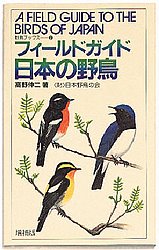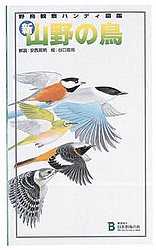Field Guides to the Birds of Japan
Looking for an English language field guide to the birds of Japan? Hop on over to Amazon and you will find the only English edition of "A Field Guide to the Birds of Japan", by the Wild Bird Society of Japan, published 1985, available from three sellers from US$178.99 to US$180.00 a copy! A little more than I'm willing to spend.
As only about 17 species are endemic to Japan, there is the option of purchasing books focusing on Korea, China and other Asian locations - a hassle in anyones book (pun intended)!
Consequently, the choice is narrowed down to guides written in Japanese and published within Japan. Many of the photographic guide books, of which there is a wide selection, provide bird names and/or scientific names in English; but generally, the quality of the photographs are surprisingly low and often birds are depicted in less than ideal conditions, often in breeding plumage only, and usually of only one sex. I have never been an advocate of photographic guidebooks and own none.
 The seminal guide to Japans bird life, using artists illustrations is "A Field Guide to the Birds of Japan" by the Wild Bird Society of Japan (see picture left). Apart from the useful English title on the cover, this guide is printed entirely in Japanese but for the birds scientific names. The book is arranged with the text facing a plate of illustrations, and details every bird that has been recorded in Japan. Small maps show colour coded seasonal distributions of individual birds across the wider Asian area.
The seminal guide to Japans bird life, using artists illustrations is "A Field Guide to the Birds of Japan" by the Wild Bird Society of Japan (see picture left). Apart from the useful English title on the cover, this guide is printed entirely in Japanese but for the birds scientific names. The book is arranged with the text facing a plate of illustrations, and details every bird that has been recorded in Japan. Small maps show colour coded seasonal distributions of individual birds across the wider Asian area.
The book runs to 340 pages and, unless you have large pockets, is not suitable for field work. Further, given the large number of birds pictured which are rarely seen in Japan, identifying a bird in the field can take a great deal of time. Many of the illustrations are also poorly executed and coloured. Worth obtaining, but as a desk top reference only.


For field work, the newer 'handy guides' (see pictures above) - "Shin Mizube no Tori" (The New Birds of the Waterside) and "Shin Sanya no Tori" (The New Birds of the Countryside) - translations my own - also published by the Wild Bird Society of Japan, are far superior.
Both of these volumes slip easily into any coat pocket, weighing next to nothing at only 64 pages each, and cost just 524 Yen a copy. Updated and superior artist illustrations detail only the most commonly seen birds, with summer and winter migrants clearly marked with sun or snowman icons respectively. Transitory birds are also marked with a green 'flying bird' icon, and birds found only in the northern or southern areas of Japan are marked with the Kanji symbols for North and South accordingly - thereby eliminating the need for maps.
No English is used in either guide. Only Japanese bird names are provided, and only in Katakana (a form of Japanese script). No scientific names are given, and only the barest of details useful for identification in the field are provided for each bird. Arrows point to key identification features on the illustrations, and in "Shin Sanya no Tori" the most commonly seen birds are found at the front of the book as well as within the main body of the guide. "Shin Mizube no Tori" provides an index to both guides.
While learning Kanji is a long-term commitment, learning to read and write Katakana and Hiragana can be accomplished in only a couple of evenings given the right level of commitment - enabling anyone to quickly read the names of each bird from these guides. Then using Japanese-English Checklists (such as this) users can quickly arrive at their English equivalents. These are the guides I carry and which I see most Japanese birders using in the field.
 For good coverage of Japans Sandpiper and Plover population I carry the 1,200 Yen "Shigi - Chidori-rui Handobukku" ("Sandpiper - Plover Handbook") by Osao Ujihara and Michiaki Ujihara (see picture left). This is a glossy, thin 66 page volume that slips easily into a coat pocket, and covers 75 species that have been recorded in Japan.
For good coverage of Japans Sandpiper and Plover population I carry the 1,200 Yen "Shigi - Chidori-rui Handobukku" ("Sandpiper - Plover Handbook") by Osao Ujihara and Michiaki Ujihara (see picture left). This is a glossy, thin 66 page volume that slips easily into a coat pocket, and covers 75 species that have been recorded in Japan.
Most species are depicted with several illustrations covering plumage variations and species variants. The illustrations are excellent, with each illustrator having his own unique style: Michiaki Ujihara - angular lines and broad brush strokes, Osao Ujihara - smooth lines and fine detail. Common and scientific names are provided in English, but the text is completely in Japanese.
As only about 17 species are endemic to Japan, there is the option of purchasing books focusing on Korea, China and other Asian locations - a hassle in anyones book (pun intended)!
Consequently, the choice is narrowed down to guides written in Japanese and published within Japan. Many of the photographic guide books, of which there is a wide selection, provide bird names and/or scientific names in English; but generally, the quality of the photographs are surprisingly low and often birds are depicted in less than ideal conditions, often in breeding plumage only, and usually of only one sex. I have never been an advocate of photographic guidebooks and own none.
 The seminal guide to Japans bird life, using artists illustrations is "A Field Guide to the Birds of Japan" by the Wild Bird Society of Japan (see picture left). Apart from the useful English title on the cover, this guide is printed entirely in Japanese but for the birds scientific names. The book is arranged with the text facing a plate of illustrations, and details every bird that has been recorded in Japan. Small maps show colour coded seasonal distributions of individual birds across the wider Asian area.
The seminal guide to Japans bird life, using artists illustrations is "A Field Guide to the Birds of Japan" by the Wild Bird Society of Japan (see picture left). Apart from the useful English title on the cover, this guide is printed entirely in Japanese but for the birds scientific names. The book is arranged with the text facing a plate of illustrations, and details every bird that has been recorded in Japan. Small maps show colour coded seasonal distributions of individual birds across the wider Asian area.The book runs to 340 pages and, unless you have large pockets, is not suitable for field work. Further, given the large number of birds pictured which are rarely seen in Japan, identifying a bird in the field can take a great deal of time. Many of the illustrations are also poorly executed and coloured. Worth obtaining, but as a desk top reference only.


For field work, the newer 'handy guides' (see pictures above) - "Shin Mizube no Tori" (The New Birds of the Waterside) and "Shin Sanya no Tori" (The New Birds of the Countryside) - translations my own - also published by the Wild Bird Society of Japan, are far superior.
Both of these volumes slip easily into any coat pocket, weighing next to nothing at only 64 pages each, and cost just 524 Yen a copy. Updated and superior artist illustrations detail only the most commonly seen birds, with summer and winter migrants clearly marked with sun or snowman icons respectively. Transitory birds are also marked with a green 'flying bird' icon, and birds found only in the northern or southern areas of Japan are marked with the Kanji symbols for North and South accordingly - thereby eliminating the need for maps.
No English is used in either guide. Only Japanese bird names are provided, and only in Katakana (a form of Japanese script). No scientific names are given, and only the barest of details useful for identification in the field are provided for each bird. Arrows point to key identification features on the illustrations, and in "Shin Sanya no Tori" the most commonly seen birds are found at the front of the book as well as within the main body of the guide. "Shin Mizube no Tori" provides an index to both guides.
While learning Kanji is a long-term commitment, learning to read and write Katakana and Hiragana can be accomplished in only a couple of evenings given the right level of commitment - enabling anyone to quickly read the names of each bird from these guides. Then using Japanese-English Checklists (such as this) users can quickly arrive at their English equivalents. These are the guides I carry and which I see most Japanese birders using in the field.
 For good coverage of Japans Sandpiper and Plover population I carry the 1,200 Yen "Shigi - Chidori-rui Handobukku" ("Sandpiper - Plover Handbook") by Osao Ujihara and Michiaki Ujihara (see picture left). This is a glossy, thin 66 page volume that slips easily into a coat pocket, and covers 75 species that have been recorded in Japan.
For good coverage of Japans Sandpiper and Plover population I carry the 1,200 Yen "Shigi - Chidori-rui Handobukku" ("Sandpiper - Plover Handbook") by Osao Ujihara and Michiaki Ujihara (see picture left). This is a glossy, thin 66 page volume that slips easily into a coat pocket, and covers 75 species that have been recorded in Japan.Most species are depicted with several illustrations covering plumage variations and species variants. The illustrations are excellent, with each illustrator having his own unique style: Michiaki Ujihara - angular lines and broad brush strokes, Osao Ujihara - smooth lines and fine detail. Common and scientific names are provided in English, but the text is completely in Japanese.


3 Comments:
Hi Tokyo Birder, you are linked to my birding blog now ! May I ask you if you know the Japanese Gull guide of the Ujihara's ? Is it a photographic or a drawn book ? Do you know if Amazon Japan send book also to Italy ?
Cheers
Italian Birder
Hi and thanks for the link. I'm glad you have found the site useful.
The book you are refering to is the "Kamome Shikibetsu Handbook", published in 2000. Illustrations are drawn. I hope to write more on it when I pick up a copy for myself soon.
I believe the Amazon Japan does ship world-wide. You can shop in English on their site by clicking on "Display in English" at the top right corner. Here is a link to this book -
http://www.amazon.co.jp/exec/obidos/tg/detail/-/books/4829921471/249-6528407-2210751
In addition to the Yacho no Kai book, I also use "Nihon no Yacho 590," which (though written in Japanese) has English and Latin names, as well as nice photos, which often helps in contrast to the Yacho no Kai book's illustrations.
I also got the "Nihon no Tancho-chi" "Birder Special" guide for Kanagawa, Tokyo, Saitama and Chiba, a pretty good guide to birding spots, with lists of birds to be found in specific locations, and when the best birding times are.
Post a Comment
<< Home